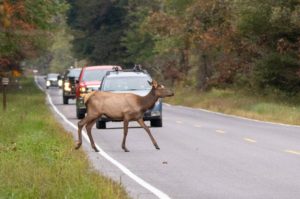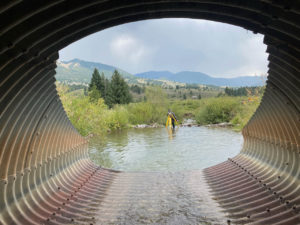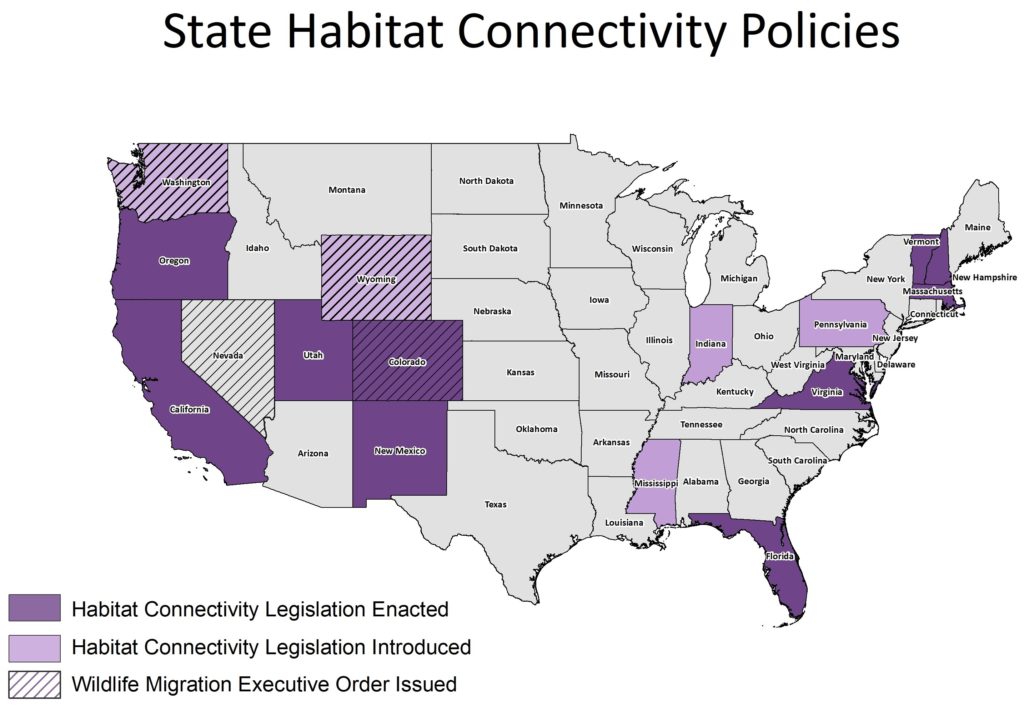In 2022, states across the country have passed legislation to take advantage of historic, new federal funding for wildlife crossing structures. Over just the past six months, seven states have enacted laws that set aside the required state match to federal grants for infrastructure projects that reconnect habitat. Many of these state policies also facilitate coordination between transportation and natural resource agencies—as well as collaboration with diverse stakeholders—to identify projects that will most effectively reduce wildlife-vehicle collisions and improve habitat connectivity.
Since becoming law last November, the Bipartisan Infrastructure Law has spurred an unprecedented flurry of activity across the country to advance transportation projects that not only address the needs of drivers, but also the needs of wildlife that have to move between habitats bisected by our nation’s extensive highway system. The federal legislation established the nation’s first-ever dedicated pot of funding for infrastructure projects that allow fish and wildlife to safely cross over or under roads. This new “Wildlife Crossings Pilot Program” will distribute $350 million in grants over the next five years to state, local, tribal, and regional agencies to build structures that reconnect aquatic and terrestrial habitat while reducing wildlife-vehicle collisions. The new law also makes these projects eligible for funding under additional federal transportation programs, unlocking many additional billions of dollars.

This is a wise investment, given that wildlife-vehicle collisions are becoming an increasingly significant and urgent public safety, economic, and natural resource management issue. These tragic accidents kill millions of animals, kill hundreds of people, injure more than 26,000 people, and cause nearly $10 billion of damage annually. Wildlife crossings are a proven solution that reduce these costly and devastating collisions by up to 97%—and the structures pay for themselves relatively quickly.
That’s why states from coast to coast have built these structures to protect motorists as well as species ranging from tortoises to panthers and from salmon to elk. While this progress is encouraging, many other worthy projects have languished due to a lack of funding for wildlife crossings. The grant programs under the Bipartisan Infrastructure Law are beginning to address that major financing barrier and have motivated states to enact the set of policies summarized below.
California
The newest of these bills is California’s Safe Roads and Wildlife Protection Act (AB-2344), which passed on August 30, 2022, and is now headed to Governor Newsom’s desk for his signature. This legislation directs the state’s transportation and wildlife agencies to identify and address barriers to wildlife movement when designing and implementing transportation projects within important habitat connectivity areas. More specifically, the statute establishes the Transportation Wildlife Connectivity Remediation program to fund projects that address inventoried habitat connectivity needs.
This year, the California legislature and governor are also setting aside $50 million for wildlife crossings, including $10 million for the new Wallis Annenberg Wildlife Crossing (featured in the rendering at the top of this page). This project in Liberty Canyon is expected to enable mountain lions—a candidate for listing under the California Endangered Species Act—to safely cross the 101 Freeway near Santa Monica.
Massachusetts
In August, Governor Baker signed transportation bill H. 5151. The legislation includes a provision directing the Massachusetts Department of Transportation, in coordination with the Executive Office of Energy and Environmental Affairs, to evaluate potential wildlife crossing projects throughout the state and publish the findings by the end of the year. The new statute specifically directs the agencies to consider the eligibility criteria in the new federal Wildlife Crossings Pilot Program to determine the feasibility of potential projects.

Colorado
In June, Governor Polis signed into law the Safe Crossings for Colorado Wildlife and Motorists Act (SB22-151). This legislation, championed by a bipartisan group of lawmakers and diverse set of stakeholders (including the Center for Large Landscape Conservation), creates a $5 million fund for measures to reduce wildlife-vehicle collisions and reconnect habitat fragmented by roads across the state. The new statute encourages the Colorado Department of Transportation to work with the Department of Natural Resources and the Colorado Wildlife & Transportation Alliance to identify these projects. Additionally, in April, the Colorado legislature passed HB22-1072, which expands the scope of the Habitat Partnership Program to fund efforts to conserve wildlife migration.
Oregon
In April, Governor Brown signed into law an appropriations bill (HB 5202), which allocates $7 million for projects that reduce wildlife-vehicle collisions and improve habitat connectivity. The bill also includes an additional $8 million for projects to remove barriers that currently prevent fish from moving freely through the state’s rivers and streams (“fish passage”).

Wyoming
In March, Governor Gordon signed SF0048, which provides additional funding for the Wyoming Wildlife & Natural Resource Trust. This legislation approves funding for specific wildlife crossings and aquatic connectivity initiatives. This includes projects to help mule deer safely get across Interstate 25 and to improve fish passage on the Henry’s Fork river.
Utah
Also in March, Governor Cox signed the Wildlife Accident Protections Act (H.B. 427), which requires the Utah Department of Transportation to include an analysis of wildlife and livestock mitigation measures in their annual report on the status of state transportation systems. The Utah legislature also set aside a $1 million appropriation for measures to reduce wildlife-vehicle collisions at the junction of Interstates 80 and 84.
New Mexico
In February, the New Mexico legislature approved $2 million for projects to reduce wildlife-vehicle collisions. This funding will allow the state’s Department of Transportation and Department of Game to implement their Wildlife Corridors Action Plan. The plan identifies 11 priority areas for wildlife crossings, based on both habitat connectivity science and collision data.

The 2022 tidal wave of state wildlife crossing legislation demonstrates that there is a growing, bipartisan movement sweeping the nation to address the pressing dual problems of habitat fragmentation and road safety. The federal Bipartisan Infrastructure Law has finally provided the financial incentives and resources necessary to galvanize these efforts and promote collaboration between state agencies and with non-governmental partners.
The states featured above are well-positioned to take advantage of this historic federal funding opportunity. Moreover, they can provide inspiration for other state lawmakers to enact policies that will enable them to reconnect landscapes, make roads safer, protect wildlife, and restore fisheries.
Learn More
For guidance on developing legislation to conserve wildlife migration and improve habitat connectivity, explore our “Wildlife Connectivity: Opportunities for State Legislation” resource.
To read more on the Wildlife Crossings Pilot Program and best practices for designing effective wildlife infrastructure projects, check out our toolkit.
For a review of state habitat connectivity policies enacted in 2021, check out our blog post, as well as Conservation Corridor’s policy digests and policy library.
For a summary of all the major federal and state connectivity policies (and a sampling of significant tribal, regional, and county policies) enacted from 2007 to 2021, view our Ecological Connectivity Policy Compendium.
To learn more about the Center for Large Landscape Conservation’s Corridors & Crossings Program, visit our webpage.
For more information related to the content of this post, contact Emily Blanchard, Policy & Planning Specialist or Anna Wearn, Director of Government Affairs.
A version of this post also appears on ConservationCorridor.org
Top photo: Once completed, the Wallis Annenberg Wildlife Crossing will be the largest of its kind in the world and will set a new standard for urban wildlife connectivity, connecting habitat for mountain lions and many other species in the greater Los Angeles area. Image courtesy of Living Habitats and National Wildlife Federation



